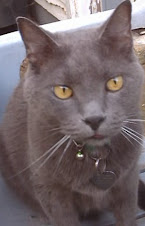 I started by making my favorite background: credit card scraping. This is the easiest and most fun background I know, and I go back to it time and time again, oftentimes experimenting with various colors. This time I used cheap bottled acrylics in red, yellow, and lavender. One of the reasons I like this technique is because it uses very little paint, so when you are down to the last dregs of your paint color, you can still get decent coverage.
I started by making my favorite background: credit card scraping. This is the easiest and most fun background I know, and I go back to it time and time again, oftentimes experimenting with various colors. This time I used cheap bottled acrylics in red, yellow, and lavender. One of the reasons I like this technique is because it uses very little paint, so when you are down to the last dregs of your paint color, you can still get decent coverage. I made a comment on ABC about "dry glue," saying that this phrase was an oxymoron if I ever heard one. From this, the idea germinated and I decided to host this swap.
I made a comment on ABC about "dry glue," saying that this phrase was an oxymoron if I ever heard one. From this, the idea germinated and I decided to host this swap. I knew I wanted to use the phrase "dry glue" although it was not on any oxymoron list. However, I was not sure how to represent the phrase or how to turn it into art. Then I remembered a technique I learned years ago about dribbling glue all over a sheet of card stock, allowing the glue to dry, then using either pigment or dye inks DTP (direct to paper) and buffing off the glue. When I was planning the spread, I wanted to use the same background on both sides. On the left is my "dry glue" tip-in, which didn't exactly turn out as planned.
What did I learn from this experiment? First, paint is wet, ink in stamp pads is not. When dry, the only way to remove (or buff away) the paint is to use a wet rag, which in turn never gets all the paint and reactivates the Elmers glue I used. Something so deceptively simple, alluded my thought processes. I can assure you, I won't make that mistake again, and if you decide to try this technique, use only ink pads, so the glue doesn't get wet in the process of buffing it. Also, it took two days for the glue to completely dry since I applied it really, really thick.
On the right is the back of my tip-in: pretty ugly. This was actually the first side I created, and YES, I rubber stamped the swirls on both sides. The old woman/young girl is a classic Gestalt illusion, and I immediately thought of it to represent this oxymoron. The image was printed separately, cut out, then lined with first black sharpie, then gold leaf (which incidentally covered up the black), then red sharpie. This is the first time I've outlined an image using multiple colors. Although it's difficult to tell from the scan, the image is raised away from the background using dimensional tape.
You can get a better view if you click on the images.
 To give people the idea of what an oxymoron was, I created this simple piece in Photoshop. I swear, I spent more time trying to figure out how to do this simple illustration than I would have if I had made it the conventional way using scissors and glue. I SO admire those who work in Photoshop and other digital software programs. Anyone who doesn't think digital spreads don't take talent, have never tried to create something this way.
To give people the idea of what an oxymoron was, I created this simple piece in Photoshop. I swear, I spent more time trying to figure out how to do this simple illustration than I would have if I had made it the conventional way using scissors and glue. I SO admire those who work in Photoshop and other digital software programs. Anyone who doesn't think digital spreads don't take talent, have never tried to create something this way.




















































































.JPG)

























0 thoughtful remarks:
Post a Comment